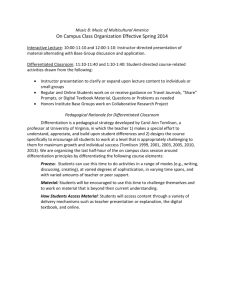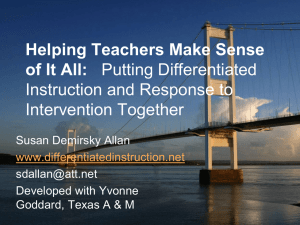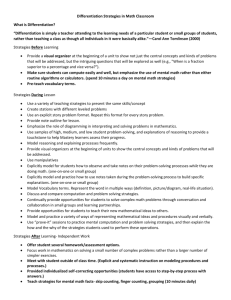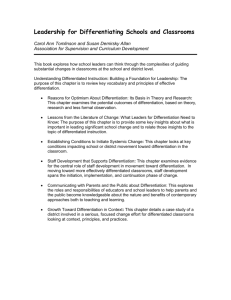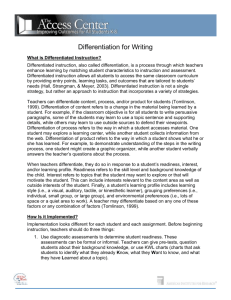Wall07 - Wikispaces
advertisement
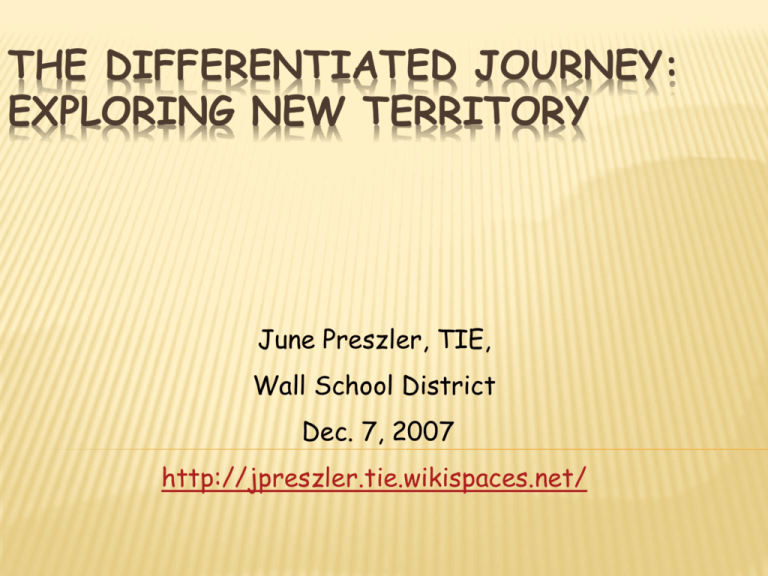
THE DIFFERENTIATED JOURNEY: EXPLORING NEW TERRITORY June Preszler, TIE, Wall School District Dec. 7, 2007 http://jpreszler.tie.wikispaces.net/ GOALS: Defining differentiation Considering choice Finding differentiation through choice Using differentiation and choice PATH OF DIFFERENTIATION What exactly is differentiation? ONE POSSIBLE DI DEFINITION Differentiation is classroom practice that looks eyeball to eyeball with the reality that kids differ, and the most effective teachers do whatever it takes to hook the whole range of kids on learning. (From Carol Ann Tomlinson, ASCD) BEAUTY OR HAG? WHAT DI IS… Multiple approaches Student centered Ebb and flow Different learning modalities Student competes against self Flexible use of classroom time Carol Ann Tomlinson, The Differentiated Classroom, 1999 BELIEFS BEHIND DI Learning profiles differ Making meaning priority Opportunity for choice Differentiation of Instruction Differentiation Strategy Booklets, 4-6 guided by general principles of differentiation such as: respectful tasks flexible grouping ongoing assessment teachers can differentiate Content Process Product according to students’ Readiness Interests Learning Profile through a range of instructional and management strategies PREP STEPS Start small—one strategy, one area. Start with what is—mine ideas; determine what all students will do, what some students will do; identify basic and advanced activities. Get students ready—discuss differences, organize, “fair” not “same.” POWER OF CHOICE Choice Theory (Glasser and Erwin) Five basic needs that drive all behavior: Survival Love and belonging Power Freedom Fun POWER Power over Power within Power with COUNTING COUP The concept: Counting Coup What do you think it means? Think-Ink-Pair-Share—Content Area Writing, 12-13 THE ENEMY IN FRONT OF US Not a person But a thing “The biggest enemy our children have are those things sitting in front of you and they’re called books.”—Gerard Baker THE WARRIOR “What do you do with your enemies? You conquer them.” “We have to redefine our enemies and conquer them.” COUNTING COUP “We have to count coup on books.” Three-Minute Pause (Write) (Struggling Readers, 21) Vocabulary Notebook/Map Define Counting Coup in your own words Compare it to something else Draw it Explain it HOW DID WE DO? In what ways did the Counting Coup activity differentiate? How could you use this type of activity or a variation of it when teaching vocabulary? THE (BATTLE) PLAN Identifying the enemy Empowering the student Becoming a warrior Conquering the enemy BEFORE YOU BEGIN… Know Understand Do Differentiate, 4-12, pages 6-7 Let’s apply it to Counting Coup I WANTED YOU TO Know the historical context of counting coup. Understand that counting coup can be applied to more contemporary situations, including the struggles that students face in schools. Do a drawing depicting your understanding of the concepts and be able to explain that interpretation to group. Furthermore, I wanted you to consider how this concept might affect the way you approach students. BEFORE YOU BEGIN… Unit: Virtual Worlds Lesson: Second Life—Virtual Communities Know: Understand: What it is, what it looks like, its economy, its residents and visitors Blurring boundaries between virtual and reality, how its evolution may impact us Do: Show how your understanding has evolved. Navigate the world. Share what you’ve learned with a colleague. On Target, Differentiating Grades 4-12, pages 6-7 ACTIVATION THE ABC WAY Virtual World of Second Life Independently work chart Share with partner or small group Share with class Write a prediction of what you think you’ll learn On Target, Reading Strategies to Guide Learning, page 7 IRA LEVIN’S SCIENCE FRIDAY HTTP://WWW.SCIENCEFRIDAY.COM/VIDEOS/WATCH/14 CNN enters the virtual world reporting the news as it happens in Second Life (11/13/07) CNN I-REPORT HUB IN SECOND LIFE CSI: SOLVING CRIMES IN SECOND LIFE HTTP://WWW.YOUTUBE.COM/WATCH?V=KFXB6ZB6UPC HTTP://ALPHA.CBS.COM/PRIMETIME/CSI_NY/SECOND_LIFE/# EVEN 2ND LIFE HAS TO UPGRADE! SECOND LIFE INVESTIGATION In your group, read the article provided. As you learn more information, jot down the ideas on your ABC chart. As you read, mark on the text as follows: ???—To show questions that arise !!!—New and interesting ideas Variations of Insert Notes, Reading Strategies to Guide Learning, page 19 Share one new and interesting thing you’ve learned. THINK-TAC-TOE (CHOICE BOARDS) Allows students choice Incorporates learning preferences Takes readiness into account (basic and advanced) Provides framework On Target Differentiated Instruction , Grades 4-12, pages 14-15 http://webtech.cherokee.k12.ga.us/littleriver-es/ewilliams/tictactoeoceania.htm CHOICE BOARD del.icio.us Avatar Argument You Tube Assessment Code of Honor Science Fiction Island Power Point MENU APPROACH Main dish: Everyone Side dish: Pick and choose Dessert: Optional but irresistible On Target, Differentiated Instruction, Grades 412, pages 10-11 DID WE SUCCEED? Know: Understand: Do: What it is, what it looks like, its economy, its residents and visitors Blurring boundaries between virtual and reality, how its evolution may impact us Show how your understanding has evolved. Navigate the world. Share what you’ve learned with a colleague. On Target, Differentiating Grades 4-12, pages 6-7 TIERED INSTRUCTION Make slight adjustments within same lesson to meet individual needs. Students learn same skills and concepts but through varying modes and activities. Appropriately challenges ability levels On Target, Differentiated Instruction, Grades 4-12, pages 8-9 STEPS IN TIERING Identify key concepts and understandings Pre-assess based on readiness, interests or learning profiles Identify how you will cluster groups/activities Select elements to tier (content, process, product) Create variations for each group CUBING Looks at topics from different angles Eliminates flat thinking Includes six commands and a prompt Describe, compare, associate, analyze, apply or use, argue for or against On Target, Differentiated Instruction, Grades 4-12, pages 12-13 THINKDOTS Strategy used to review, demonstrate, and extend thinking Can be developed to respond to learner readiness, learning profiles, student choice Variation of cubes; works well with older students LAYERED CURRICULUM Kathy Nunley Levels or layers of learning The 3-layer model requires more complex thinking to earn a higher letter grade. Focus on quality of learning and thinking rather than quantity of time and activities for higher grades On Target Grades, Differentiated Instruction, 4-12, page 19 THE LEVELS A: Critical Thinking B: Application C: Basic Learning and Skills C Level reflects what EVERY student must be able to KNOW, UNDERSTAND and DO. A LITTLE LIE GOES A LONG WAYS Three Facts and a Fib Strategies to Help Struggling Readers, page 25 THREE FACTS AND A FIB 1.When I took my son to college, I camped out in the dorm parking lot for the first night…just in case. 2.I played soccer for a championship youth team in Brazil in the 1970s. 3.In one month, I traveled over 3000 miles for education-related business, had one accident in a BHSSC/TIE vehicle, and received two undeserved speeding tickets. 4. I began my professional career as a recipe writer for the Aberdeen American News. EXIT CARDS Easy strategy for assessing student learning Students respond to prompts or questions; turn in cards as they leave Teacher uses card to help create groups, monitor student progress, revise lessons On Target, Strategies to Help Struggling Readers, page 27 EXIT CARDS Today you began to learn about Second Life List three things you learned Write at least one question you have about this topic EXIT CARD GROUPINGS Group 2 Group 1 Students who are struggling with the concept or skill Readiness Groups Montgomery County Public Schools, Rockville, Maryland Students with some understanding of concept or skill Group 3 Students who understand the concept or skill UNDERLYING KNOW, UNDERSTAND, DO Know: Understand: What Differentiated Instruction is, what it might look like in the classroom How DI might affect my teaching and students’ learning, the ways that DI synthesizes other strategies (literacy, Marzano) Do: Develop a DI lesson to use with your students, staff, audience OUR EXIT CARD List three things you learned today. List two questions you’d still like to explore. List one method of differentiation and/or choice that you might apply in your classroom. BUT BEFORE YOU GO… Differentiated lesson plan handout— (Return here at 2:45—I’ll be here along if you need help or would like to look at books.) When I return to Wall again: Share what you’ve tried (successes and not so successful ) Technology and differentiation Feb. 8, 2008


